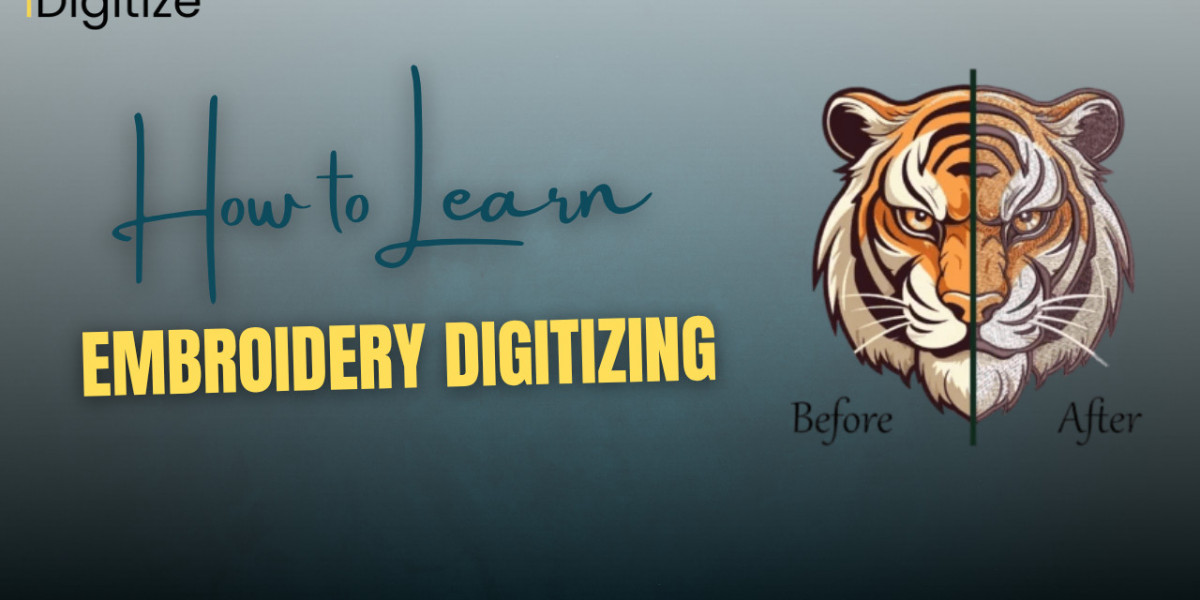Embroidery digitizing is the process of converting digital artwork into machine-readable stitch files, enabling the creation of high-quality embroidered designs on apparel, accessories, and more. Learning this skill opens doors for small business owners, hobbyists, and artisans to produce professional-grade embroidery for branding or personal projects. While digitizing can seem complex, with the right approach, tools, and practice, anyone can master it. iDigitize offers expert services to complement your learning journey, but this blog provides a step-by-step guide to learning embroidery digitizing, along with practical tips to help you succeed.
Understand the Basics of Embroidery Digitizing
Before diving into embroidery digitizing, familiarize yourself with its core concepts. Digitizing involves creating a stitch file that instructs an embroidery machine on stitch types, directions, density, and color sequences. Understanding these elements is crucial for producing clean, professional designs.
What to Learn: Study stitch types (satin, fill, running), underlay stitches, stitch density, and fabric considerations. Learn about file formats like DST, PES, or JEF, which vary by machine.
How to Start: Read beginner guides or watch YouTube tutorials on platforms like Embrilliance or Hatch Embroidery to grasp the fundamentals.
Why It Helps: A solid foundation ensures you understand how design choices impact the final embroidery, setting you up for success.
Choose the Right Digitizing Software
Selecting user-friendly, feature-rich software is essential for learning digitizing. Popular options include Embrilliance StitchArtist, Hatch Embroidery, Wilcom EmbroideryStudio, and free tools like Ink/Stitch.
Tip: Start with beginner-friendly software like Embrilliance (starting at $169) or Ink/Stitch (free, based on Inkscape). These offer intuitive interfaces and tutorials for new users.
How to Choose: Opt for software with free trials, robust community support, and compatibility with your embroidery machine. Ensure it supports your machine’s file format.
Why It Helps: The right software simplifies learning, providing tools and resources to practice digitizing effectively.
Take Online Courses or Tutorials
Structured learning through online courses or tutorials accelerates your mastery of digitizing. Many platforms and software providers offer comprehensive resources tailored for beginners.
Tip: Enroll in courses from sites like Embroidery Library University, Udemy, or software-specific platforms (e.g., Hatch’s 200+ lessons). Watch free YouTube tutorials for hands-on demonstrations.
What to Focus On: Learn how to import artwork, set stitch types, adjust density, and create underlay stitches. Practice with simple designs like text or basic logos.
Why It Helps: Guided instruction builds skills systematically, helping you understand both technical and creative aspects of digitizing.
Practice with Simple Designs
Hands-on practice is critical for learning digitizing. Start with simple designs to build confidence before tackling complex logos or patterns.
Tip: Begin with basic shapes, single-color text, or small logos. Use sample designs provided by your software or create your own using vector graphics tools like Adobe Illustrator or Inkscape.
How to Practice: Digitize a design, test it on your machine with a fabric sample, and analyze the results for issues like gaps or puckering.
Why It Helps: Practicing simple designs helps you master stitch settings and software tools, preparing you for more advanced projects.
Learn About Fabrics and Their Impact
Fabrics like cotton, knits, fleece, or silk require different digitizing settings to achieve clean results. Understanding how fabrics affect embroidery is key to successful digitizing.
Tip: Study how stitch density, underlay, and pull compensation vary by fabric. For example, use lighter density for stretchy knits and stronger underlay for thick fleece.
How to Learn: Experiment with test stitch-outs on different fabrics or consult fabric guides in software documentation or online forums.
Why It Helps: Fabric knowledge ensures your designs are tailored to specific materials, preventing issues like puckering or distortion.
Master Machine Compatibility
Each embroidery machine has unique requirements, such as supported file formats (DST, PES, JEF) and limitations like hoop size or stitch count. Learning to create compatible files is essential.
Tip: Check your machine’s manual for supported formats and specifications. Practice saving files in the correct format and test them on your machine.
How to Learn: Join online communities (e.g., Embroidery Garden or Reddit’s r/Machine_Embroidery) to learn about common machines and their settings.
Why It Helps: Compatible files ensure seamless stitching, reducing errors and saving time during production.
Perform and Analyze Test Stitch-Outs
Test stitch-outs are crucial for evaluating your digitized files before full production. They reveal issues like thread breaks, misalignment, or incorrect density that need adjustment.
Tip: Stitch your design on a fabric sample similar to your final material. Check for clarity, stitch coverage, and tension, then tweak the file as needed.
How to Learn: Practice analyzing stitch-outs by noting issues and experimenting with software adjustments, such as reducing density or adding underlay.
Why It Helps: Test stitch-outs build your ability to refine designs, ensuring professional results. iDigitize includes this step in our services to guarantee quality.
Join Embroidery Communities
Online communities and forums provide valuable support, tips, and feedback from experienced digitizers. Engaging with others accelerates your learning and exposes you to new techniques.
Tip: Join groups like the Embroidery Digitizing Facebook Group, Sew Inspired by Bonnie, or forums on sites like EmbroideryDesigns.com. Share your work and ask for feedback.
How to Learn: Participate in discussions, watch live tutorials, or collaborate on group projects to gain insights from peers.
Why It Helps: Communities offer real-world advice and inspiration, helping you troubleshoot issues and stay motivated.
Experiment with Advanced Techniques
Once you’re comfortable with basics, explore advanced digitizing techniques like 3D puff embroidery, appliqué, or multi-color designs to expand your skills.
Tip: Use software tutorials to learn techniques like 3D puff (for raised effects) or appliqué (combining fabric patches with stitches). Start with small projects to practice.
How to Learn: Watch advanced tutorials from software providers or experiment with sample files to understand complex stitch settings.
Why It Helps: Mastering advanced techniques enhances your versatility, allowing you to offer unique designs for clients or personal projects.
Consider Professional Services for Support
While learning digitizing, partnering with professional services can complement your efforts, especially for complex or high-volume projects. iDigitize provides expert files to meet your needs while you develop your skills.
Tip: Use professional services for intricate designs or tight deadlines, studying their files to learn optimization techniques like stitch pathing or density settings.
How to Learn: Compare professional files to your own, noting differences in stitch types, underlay, or color management to improve your technique.
Why It Helps: Professional services save time and provide high-quality examples, accelerating your learning curve and ensuring project success.
Conclusion
Learning embroidery digitizing is an achievable goal with the right tools, resources, and practice. By understanding the basics, choosing user-friendly software, practicing with simple designs, and engaging with communities, you can master this valuable skill. Experimenting with fabrics, performing test stitch-outs, and exploring advanced techniques will further refine your abilities. Partnering with iDigitize can support your journey, providing professional files while you learn. Whether you’re a small business owner or a hobbyist, these tips will help you create stunning, professional embroidery with confidence and precision.
FAQs
What is the first step to learning embroidery digitizing?
Start by understanding stitch types, underlay, density, and file formats through beginner guides or tutorials to build a strong foundation.
Which software is best for beginner digitizers?
Embrilliance StitchArtist and Ink/Stitch are ideal for beginners due to their user-friendly interfaces, tutorials, and affordable or free options.
How can I practice digitizing effectively?
Start with simple designs like text or shapes, perform test stitch-outs on similar fabrics, and analyze results to refine your skills.
Why do fabrics matter in digitizing?
Different fabrics require specific stitch settings to avoid puckering or distortion, ensuring clean, professional embroidery results.
How do I ensure my files work with my embroidery machine?
Check your machine’s supported formats (e.g., DST, PES) and test files on your machine to confirm compatibility and performance.
Can professional services help me learn digitizing?
Yes, professional services like iDigitize provide high-quality files you can study, offering insights into advanced techniques while meeting project needs.








